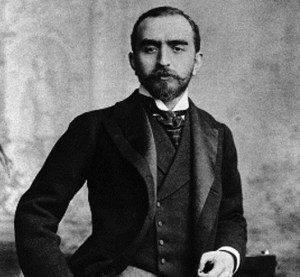Calouste Gulbenkian was born on March 23rd, 1869 in Ottoman Empire, today´s Turkey. However, people love to say that he is  British with Armenian origins. He did have British citizenship from 1902. Gulbenkian was a businessman and philanthropist, and he was notable because of his role in making the petroleum reserves of the Middle East available to Western development. Besides, he is remembered as the first person to exploit Iraqi oil. However, Gulbenkian was also remembered for something more noble and famous – his art collection. As Gulbenkian moved and travelled a lot including cities like Constantinople, London, Paris, and Lisbon, he made a collection of the great art pieces gathered in these cities. His souvenirs from travels were his “children” as he referred to them, became one of the most amazing collections.
British with Armenian origins. He did have British citizenship from 1902. Gulbenkian was a businessman and philanthropist, and he was notable because of his role in making the petroleum reserves of the Middle East available to Western development. Besides, he is remembered as the first person to exploit Iraqi oil. However, Gulbenkian was also remembered for something more noble and famous – his art collection. As Gulbenkian moved and travelled a lot including cities like Constantinople, London, Paris, and Lisbon, he made a collection of the great art pieces gathered in these cities. His souvenirs from travels were his “children” as he referred to them, became one of the most amazing collections.
In his early twenties, Gulbenkian moved to London, to escape the Hamidian massacres of Armenians. In London, he became involved in oil business which soon brought him unexpected success. Following these accomplishments, Gulbenkian became a financial and economic adviser to the Turkish Embassies first in London and then also in Paris. Later, Gulbenkian also became a chief financial advisor to the Turkish government. His great work ethics and persistence lead to the achievements in different fields.
However, this great man never forgot his origins and was dedicated to helping Armenian families. His philanthropic activities involved the establishment of schools, hospitals, and churches, and his legacy still lives through the Calouste Gulbenkian Foundation which was founded in 1956. This foundation, based in Lisbon, still continues to promote arts, education, science, music and charitable work all around the world. It is one of the largest foundations in Europe.
After he had died in July 1955, he left behind the collection of almost 6,000 art pieces, and the testament in which he requires the establishment of the museum which will be a home for all his “children.” It is the wish which was at the time hard to grant. However, fourteen years after his death, after long-term negotiations and agreements, it was possible to make his vision come true. Gulbenkian Museum was built in Lisbon, and up to this day, it opens its doors to art lovers from all over the world. Gulbenkian had a really exceptional taste for art, and he equally loved paintings, sculpture and decorative arts, as well as other art pieces, which can be seen in his unique collection.